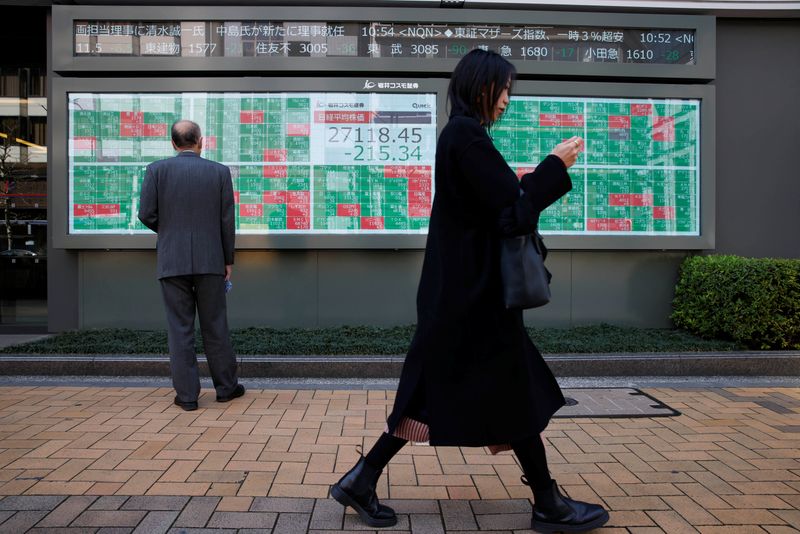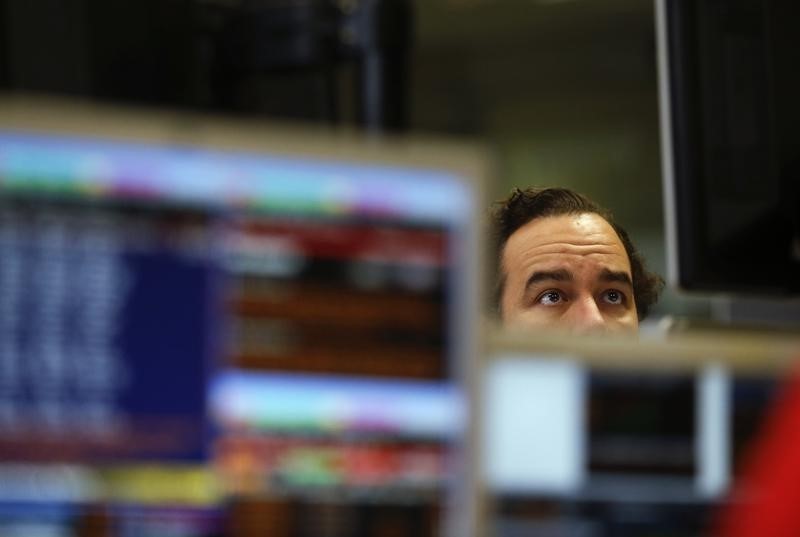
© Reuters. FILE PHOTO: A woman walks past a man examining an electronic board showing Japan’s Nikkei average and stock quotations outside a brokerage, in Tokyo, Japan, March 20, 2023. REUTERS/Androniki Christodoulou/File Photo
By Dhara Ranasinghe
LONDON (Reuters) -U.S. stock futures looked to open lower on Tuesday as rising government bond yields unnerved investors, while rate cuts from China and disappointing data underscored the economic malaise gripping the world’s second biggest economy.
U.S. stock future indices both declined about 0.6% while Asian shares fell 0.4%.
hit year highs at around 4.24%, while Germany’s benchmark 10-year bond yield rose to its highest since March as a selloff in bonds, driven in part by resilient U.S. economic growth, deepened.
“We have seen resilient markets but the rise in bond yields and how that gets resolved will be important in the second half of the year,” said Tim Graf, head of EMEA macro strategy at State Street (NYSE:) Global Advisors.
Emerging markets remained in focus a day after Argentina devalued its currency by nearly 18%, while Russia’s central bank on Tuesday raised interest rates by 350 basis points at an extraordinary meeting following a fresh slide in the rouble.
European stocks fell almost 0.8%. UK and Swedish stocks led declines among European peers after inflation data from both countries triggered worries about high interest rates.
This all left MSCI’s world equity index, heading back towards five-week lows touched on Monday.
CHINA CUTS, RUSSIA HIKES
Cuts to China’s one-year loans to financial institutions, at 15 basis points, were the largest since the outset of the COVID pandemic. Industrial output and retail sales growth both slowed from a month earlier to a year-on-year pace of 3.7% and 2.5% respectively, missing expectations.
The yuan dropped to its lowest in 9-1/2 months, and sources told Reuters that China’s major state-owned banks stepped into the spot market to steady the currency. It was last trading at around 7.2865 per dollar, having been as low as 7.2899.
“The struggles of the world’s second-largest economy show that, despite the positive rhetoric emanating from Beijing, the post-pandemic economic recovery has stalled,” said Ricardo Evangelista, senior analyst at ActivTrades, who also said this might add gains to the dollar.
But the U.S. dollar had ticked down 0.1% against a basket of currencies by 1049 GMT.
“Globally, markets are right to be concerned about where China growth is going in the current quarters,” said Chris Scicluna, head of research at Daiwa Capital Markets.
MSCI’s broadest index of Asia-Pacific shares outside Japan was not far from a one-month low hit on Monday of 506.3 as worry about China’s frozen property sector swept across regional markets.
Property investment, sales and fundraising extended their slide in July, data on Tuesday showed. New construction starts by floor area are down nearly 25% year-on-year and highlight how there is neither the appetite nor funds to build.
In Britain, sterling rose and two-year British government bond yields, which are sensitive to speculation about interest rate changes, hit their highest level in a month.
That followed data showing basic wages in Britain hit a new record growth rate, adding to worries for the Bank of England (BoE) about long-term inflation pressures even after 14 back-to-back increases in interest rates.
China’s weak data overshadowed a surprise in Japan, where tourism and car exports sent annualised growth surging to 6% in the second quarter, well above the 3.1% analysts had expected. That lifted the by 0.6%. ()
The yen showed little reaction and hit a nine-month low of around 145.86 to the dollar, capped as controlled Japanese yields leave a wide gap on rising U.S. yields. [FRX/]
The euro was up about a quarter of a percent at $1.0932.
Russia’s central bank, meanwhile, hiked its key interest rate by 350 basis points to 12%, an emergency move to try to halt the rouble’s recent slide after a public call from the Kremlin for tighter monetary policy.
The rouble pared gains after the decision to stand 0.3% weaker at 98.00, but still significantly above lows near 102 on Monday which had not been hit since the early weeks after Russia invaded Ukraine.
futures were 70 cents weaker at $85.53 per barrel.








